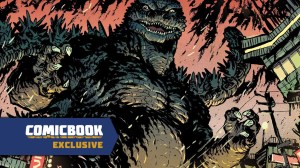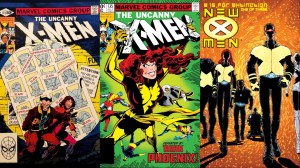The ’80s is a decade often looked at nostalgically for its fashion, music, films, and other trademark imagery, though other aspects of the time are also quite well known. Empires were built from the fortunes brought in from drugs, especially cocaine, and business and partying became one and the same in this surreal and dangerous environment. This is the world that a 15-year-old girl named Janie finds herself right in the middle of in Antarctic Press’ Hot Valley Days & Cocaine Nights by Matthew Spradlin and Sean E. DeMott, and the series follows her journey from her small town in Ohio to becoming a powerful drug hustler in L.A. and her attempt to get out of the life. ComicBook.com had the chance to speak to DeMott and Spradlin all about the series, which concludes with issue #3 and is based on a true story.
Videos by ComicBook.com
“When I was a kid I had met a bunch of these characters and I was in my late teens and met all of them, all those characters, and I had briefly for a while encountered a lot of that activity because I was in the rock and roll scene,” DeMott said. ” I was a kid that plunged into the eighties heavy metal scene in Hollywood, and so kind of like a Boogie Nights movie, there’s big house parties with Ferrari’s in the driveway and a lot of big hair and leopard print clothes and the whole thing. I kind of shimmied in and out of that crowd for a minute, and I noticed I was really just trying to get in and out and join a band, but I had become acquaintances and friends with a couple of those people and it wasn’t my scene. It was heavy to see it, and I was like, I don’t know much about the world, but I know that this doesn’t end well, and it’s turning into a giant Boogie Nights movie basically minus the sexual side. It was loud and people weren’t discrete. There were millions of dollars floating around, and I had dipped out of that.”
Years later DeMott reconnected with a woman who had experienced that world on a much more surreal and shocking level, and after hearing her story DeMott decide to purchase the rights to turn it into a series.
“Years later I had reconnected with a woman, and she was really nice and had told me kind of what happened and had gotten out the other side and I stayed in touch. I was always like, ‘God, that story’s crazy,’ but the person at the heart of the story is a really nice person, a really good-hearted person. I’m glad the well-being of that person was okay,” DeMott said. “And I just stayed in touch and gone and got the rights.”
“It’s this weird thing too because it’s not like you’re getting the rights to a bestseller or to a public thing. You’re getting the rights to someone that’s like, ‘I don’t want to be in the spotlight. I’m just glad to be okay and then I survived.’ And so it’s kind of like getting the rights to a Russian spy, but I wanted to honor the story by getting rights and not just going off and doing something with the information. And I took it to Matthew, and it’s funny, the backstory is crazy because Matthew and I have a mutual friend in the industry that works on huge studio movies and we had sat down to talk about another project,” DeMott said.

That project didn’t end up working out, but thanks to a literal elevator pitch, Hot Valley Days and Cocaine Nights was born shortly thereafter.
“I gave a 30-second pitch waiting on the elevator to come up,” DeMott said. “I hadn’t gotten in yet, and I was like, ‘Teenage runaway, Ohio, to California 15 years old becomes this blah, blah, blah, cartel, duh, duh, duh, heavy metal, ya-da-da-da, back and forth.’ And he was just like, ‘That’s unbelievable.’ He’s like, ‘Is that real?’ I go, ‘Yeah.’ He’s like, ‘Let’s talk.’”
“Yeah, that kind of grabbed me because see at the same time that Sean is in the middle of it in LA, during that period of the eighties I was in Orange County and I drive up into LA and I would see some of this craziness going on. It was a real adventure driving up from Orange County into LA at that time,” Spradlin said. “And you’d see chalk outlines of dead bodies that have been shot the night before on Hollywood Boulevard. And just the scene was wild.”
Janie’s story in the series is already compelling, but there is more that happened, and it was a challenge to fine-tune the story and figure out which elements needed to be trimmed down.
“So we talked about that, and there are definitely a lot more stories with all the characters going on, but we really, we had a bigger script and then we kept shaving it down and kept shaving it down in order to fit it,” Spradlin said. “At first, it was like, ‘Well, how many issues is this?’ And there had been a discussion going around in the comic book world, I’m sure you’re aware of it, of pages per issue, right? On a single issue. So in the past, the comics that I had done, I like giving people a lot of good story per issue. So I was just like ‘Let’s pack it. Let’s not cut the script anymore,’ we decided to do that, and said ‘let’s give at least 30 pages per issue, and let’s keep it to three issues. We’ll make three big fat issues.’”
“And so there was a lot more, some really great moments that were tough to cut out for sure, and I think we eliminated maybe one or two super peripheral characters,” Spradlin said. “But other than that, I would say it sticks pretty close to the story as to what happened and when. That was the toughest thing was getting the timeline because of everything going on and her recollection of exactly what the order was of those things happening. So that was kind of tough. And then also, when you’re bouncing back and forth, it was like checks and balances to make sure, okay, we’re not screwing up the timeline with the flashback. So all that under consideration, I think we came pretty close to hitting the target of what we wanted to hit.”

The series shows why Janie left for LA in the first place but slowly reveals her journey to LA throughout the present-day story with flashbacks, and the reason they structured it that way was in large part to keep things fresh and focus on highlighting small moments that matter to the character and not necessarily the obvious story beats.
“That’s good question, because when I was talking to Sean, I said, hey, the two best biography movies I’ve ever seen, narrative biography movies that I’ve ever seen were both by Bob Fosse,” Spradlin said. “One of them in Star 80 that’s about Dorothy Stratten, and the other one that he did is Lenny about Lenny Bruce. And both of those movies, you know how when you’ve seen all these biography movies, right, and they always hit the same beat at the same time at the same moment, A to B to C, you know what I mean? And you’re like, ‘Okay, I know this is going to happen, then this is going to happen.’ Those two by Fosse don’t do that, and he’s kind of hitting on moments that are just important moments, but they’re not necessarily the moments that you would always think of. And he would go back and then he’d go forwards, and then he would go to the middle of the story. And so those were a big influence on the writing and how we were going to structure the script.”
There was also an intention to make this a story authentic to the 80s, and that meant representing all aspects of the decade.
“And it reads authentic. We didn’t want to make… We keep saying this, we didn’t want to make a story about the ’80s when we wanted to make it from the ’80s,” Spradlin said.
“And we stuck to that because clearly there’s some dialogue in there that’s pretty raw and we were sensitive to it, but then it was like, ‘do we want to tell a watered-down fairy tale or we want to pull you into the moment?’ We want you to be standing on the shag carpet with a lava lamp, and we want you there with the bad knock-off Nagel paintings from the Valley swap meet,” DeMott said. “We really wanted you to be there, and if everything was candy-coated, we would’ve missed the mark, I think. We talked about it extensively. I’m like, ‘This is raw. This dialogue right here is harsh.’ But then it was like, ‘Hey man, people were walking around their daily circles. This is how they talk. This is what people were saying.’ And as rough as it is, we can’t pretend they weren’t saying it. But call it what it was. So that’s… We were very… It was long talks of us trying to make sure we were sensitive to it but wanted to pick the direction of authenticity, and that’s where we chose.”

The story deals with some heavy issues and themes, but it still has a surprisingly lighthearted tone in parts, and that was very intentional.
“I know that together we were both like, ‘We want this story to be fun.’ We didn’t want it to be a super dark, people getting shot all the time, that sort of drug story. And to be honest, I don’t think there really was a lot. I know there wasn’t a lot of that, even with dealing with the cartel guy for real,” Spradlin said. “He was like, we actually, going back to your earlier question, if there was anything is we kind of had to make our Mateus character, we made him slightly more sinister in the book to be a little bit more of a threat.”
“He, if there was one thing in her recollection of these characters, is that he was actually really kind of a partying guy too, and was loving being in LA at that time as well,” Spradlin said. “So, I guess what I would say is the characters, they really kind of were more of the gang that couldn’t shoot straight at that time. And people were just really so out of control, that it’s just amazing that they were able to do this whole thing was able to go forward for as long as it did, you know?”
“We didn’t want to tell… first of all if the characters were thoughtless cold people with no personalities that were just cold-blooded, money grabbers, we would have never got involved with the project, you know? The heart of the project was everything,” DeMott said. “The sincerity of a good person hanging a left turn on a road when they… people get lost, you know? And they get off on the wrong exit, and I think we were really drawn in by the heart.”

After everything Janie goes through, there is a pretty hopeful ending for her and her daughter. While her story has reached its natural conclusion here, the duo does feel there are ways to return to this world in the future.
“Well, I think of the main big story with her, that’s where we would end it with her, but Sean and I definitely have talked about more and more the other characters,” Spradlin said. “There are other stories to tell with those characters with her still being within that timeline, right? That period, the ’80s, those peripheral characters definitely could be pushed up to the front and you hear more about their story within that same timeline. As far as Jeannie is concerned, that story ends with her having her daughter or pregnant with her daughter. We feel that that was the perfect point for her exit out of that because she really did kind of leave that life at that point.”
You can check out a preview in the images above, and you can read the issue in full when Hot Valley Days & Cocaine Nights #3 hits comic stores on March 17th.





